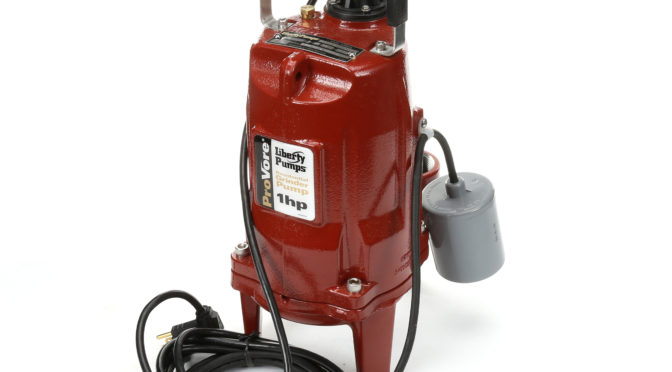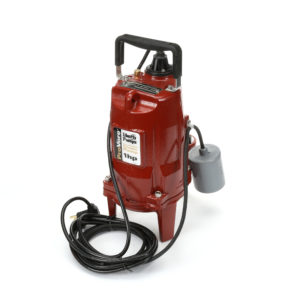 If you’re in the market for a sewer pump, it can be tempting to buy the cheapest model you find. But we’ve learned the hard way that paying less often means paying often (while spending hours knee-deep in sewage). We’ve reached the point where we’d rather pay more and buy peace of mind. When it comes to sewage pumps, that means buying sewage grinder pumps over sewage ejector pumps for most residential and all commercial-grade sewage jobs.
If you’re in the market for a sewer pump, it can be tempting to buy the cheapest model you find. But we’ve learned the hard way that paying less often means paying often (while spending hours knee-deep in sewage). We’ve reached the point where we’d rather pay more and buy peace of mind. When it comes to sewage pumps, that means buying sewage grinder pumps over sewage ejector pumps for most residential and all commercial-grade sewage jobs.
Will your house, rental, or small business collapse in a sea of sewage if you don’t buy a grinder pump? No. There are many reliable sewage ejector pumps on the market (e.g., the Zoeller M267 or Liberty Pumps LE51A) that can process 2 inch solids. However, if you need a pump that can shred tough solids like feminine hygiene products, rags, wipes, towels, and napkins, you’ll want to trust your home or business to something stronger than an ejector pump. The first time you don’t need to handle an expensive and unforeseen plumbing emergency, you’ll be glad you invested in a sewage grinder pump. None of the things above should be flushed, but there are people who flush them anyway, and a grinder pump will keep your plumbing system going when they do.
We recently looked at one of the best grinders under $1,000, the Liberty Pumps PRG101A. Today we’re going to look at several manual grinders in the same PRG series: the Liberty Pumps PRG101m, the Liberty Pumps PRG101m-2, the Liberty Pumps PRG102m, and the Liberty Pumps PRG102m-2. With the addition of a simple sewage pump controller, they’ll support a home or small business for decades. Our full review is below, and you can buy them here: PRG101m, PRG101m-2, PRG102m, and PRG102m-2.
Key Features of the Liberty Pumps PRG101m, PRG101m-2, PRG102m, and PRG102m-2 Sewage Grinder Pumps (60 Second Summary)
 The Liberty Pumps PRG101m, PRG101m-2, PRG102m, and PRG102m-2 are manual submersible residential sewage grinder pumps that can also be installed in the majority of applications requiring a standard sewage ejector pump. The differences between them are as follows: the “m” models include a 10-foot quick disconnect power cord while the “m-2” models upgrade the power cord to 25 feet. The “101” models run on 115 volts single phase and draw 12 amps at full load with a locked rotor amp draw of 47.5. The “102” models run on 230 volts single phase, draw 6 amps at full load, and the locked rotor amp draw is 23.7. Aside from that, all four models are identical. For brevity, they will be referred to as the “manual PRG” for the rest of this review.
The Liberty Pumps PRG101m, PRG101m-2, PRG102m, and PRG102m-2 are manual submersible residential sewage grinder pumps that can also be installed in the majority of applications requiring a standard sewage ejector pump. The differences between them are as follows: the “m” models include a 10-foot quick disconnect power cord while the “m-2” models upgrade the power cord to 25 feet. The “101” models run on 115 volts single phase and draw 12 amps at full load with a locked rotor amp draw of 47.5. The “102” models run on 230 volts single phase, draw 6 amps at full load, and the locked rotor amp draw is 23.7. Aside from that, all four models are identical. For brevity, they will be referred to as the “manual PRG” for the rest of this review.
The manual PRG features a 1 hp electric motor, a max pumping rate of 2,760 gallons per hour, a 50 foot maximum head, and a 3 year warranty. It is 17-5/8 inches tall, 11 inches wide, 7-1/8 inches deep, and weighs 57 pounds. It has a class 30 cast iron body, a class 25 cast iron impeller, and a 440 stainless steel cutter and cutter plate. The motor is oil-filled, thermally protected, and has thermal overload protection at 221F. The maximum liquid temperature is 140F. No float switch is included, and the discharge is 2 inch NPT.
The pumping rate drops from 2,760 GPH at zero feet to 2,610 GPH at 10 feet, 2,220 GPH at 20 feet, 1,680 GPH at 30 feet, 960 GPH at 40 feet, and shut off occurs at the max head of 50 feet.
How Do the Liberty Pumps PRG101m / PRG102m Compare to the Liberty Pumps PRG101A?
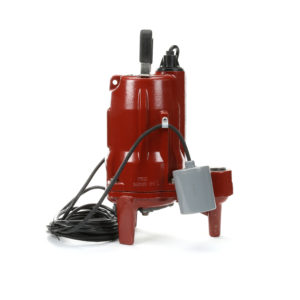 The primary difference between the manual PRG and the PRG101A is the lack of a float switch in the manual PRGs. As a result, a sump float switch will need to be purchased separately and connected; we recommend the HC5000 Sewage Pump Controller for the “101” pumps. Other differences involve power usage; while the “101” manual and identical models are the same, the “102” models use 230 volts single phase, draw 6 amps at full load, and the locked rotor amp draw is 23.7 instead of 115, 12, and 47.5 respectively. Additionally, the “m-2” models, like the “A-2”, feature a 25-foot power cord instead of a 10-foot power cord.
The primary difference between the manual PRG and the PRG101A is the lack of a float switch in the manual PRGs. As a result, a sump float switch will need to be purchased separately and connected; we recommend the HC5000 Sewage Pump Controller for the “101” pumps. Other differences involve power usage; while the “101” manual and identical models are the same, the “102” models use 230 volts single phase, draw 6 amps at full load, and the locked rotor amp draw is 23.7 instead of 115, 12, and 47.5 respectively. Additionally, the “m-2” models, like the “A-2”, feature a 25-foot power cord instead of a 10-foot power cord.
Our Short and Long Term Experiences Installing and Using the Liberty Pumps PRG101m / PRG102m Grinder Pumps
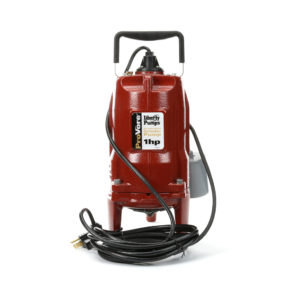 Installing the manual PRG isn’t that different from any other sewage pump installation; we’d simply recommend taking your time and making sure you have all necessary tools on hand (including extra accessories) before beginning the job so you don’t get stuck for hours or days due to breaking an essential part. Similarly, it’s a good idea to have a good wet / dry vacuum if you’re performing a DIY installation. The only significant difference between installing a manual sewage pump and an automatic one is that you’re going to have to by and install a separate sump pump controller instead of setting a built-in float switch. If the thought of managing two devices instead of one gives you a headache, you’d probably be better off going with one of the automatic PRG grinders like the PRG101A; it’ll give you one less thing to buy and will also give you more control over sump pump functionality than a separate controller.
Installing the manual PRG isn’t that different from any other sewage pump installation; we’d simply recommend taking your time and making sure you have all necessary tools on hand (including extra accessories) before beginning the job so you don’t get stuck for hours or days due to breaking an essential part. Similarly, it’s a good idea to have a good wet / dry vacuum if you’re performing a DIY installation. The only significant difference between installing a manual sewage pump and an automatic one is that you’re going to have to by and install a separate sump pump controller instead of setting a built-in float switch. If the thought of managing two devices instead of one gives you a headache, you’d probably be better off going with one of the automatic PRG grinders like the PRG101A; it’ll give you one less thing to buy and will also give you more control over sump pump functionality than a separate controller.
Once installed, you can expect a high degree of reliability; the happiest clients we’ve seen tend to be either residential or commercial owners who bought it to replace failing sewage pumps or who took the preemptive approach and installed it before disaster struck. You should be able to expect 15 to 25 years of solid functionality, although you’d do well to check on the pump far more frequently in order to make sure whatever controller you’ve installed is working well.
Troubleshooting and Installation Tips to Get Your Liberty Pumps PRG101m / PRG102m Working Sooner
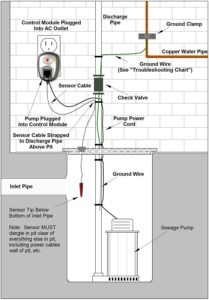
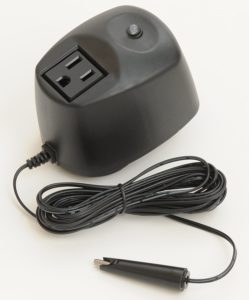 The single most important thing to keep in mind with a manual PRG installation is that you’re going to need a sewage pump controller, or sewer float switch. These are manual pumps; they aren’t going to turn themselves on or off without one. If you want an automatic float switch built in, you want the PRG1010A. However, if you’re buying a manual PRG like the PRG101m/-2 or PRG102m/-2, you’ll need something like the HC5000 Sewage Pump Controller. It’s a cheap and compact computer that connects to your sewage pump, automatically determines how large your pit is, and turns your pump on and off for you. It’s extremely reliable (rated to 350,000 cycles), extremely affordable at under $1,000, and only takes minutes to install; you don’t even need to open your sump pit to install it. We’ve seen it installed in hundreds of manual sump pumps over the years and recommend it heartily for any manual pump or automatic pump with a failed mechanical switch. It’s important to note, however, that the HC5000 only works with 115-120V pumps, so it won’t work with either of the “102” pumps, but only with the “101” pumps.
The single most important thing to keep in mind with a manual PRG installation is that you’re going to need a sewage pump controller, or sewer float switch. These are manual pumps; they aren’t going to turn themselves on or off without one. If you want an automatic float switch built in, you want the PRG1010A. However, if you’re buying a manual PRG like the PRG101m/-2 or PRG102m/-2, you’ll need something like the HC5000 Sewage Pump Controller. It’s a cheap and compact computer that connects to your sewage pump, automatically determines how large your pit is, and turns your pump on and off for you. It’s extremely reliable (rated to 350,000 cycles), extremely affordable at under $1,000, and only takes minutes to install; you don’t even need to open your sump pit to install it. We’ve seen it installed in hundreds of manual sump pumps over the years and recommend it heartily for any manual pump or automatic pump with a failed mechanical switch. It’s important to note, however, that the HC5000 only works with 115-120V pumps, so it won’t work with either of the “102” pumps, but only with the “101” pumps.
Liberty Pumps PRG101m / PRG102m Pump Pros, Cons, and Value Comparison
In conclusion, if you’re looking for a manual sewage grinder pump, these four are the best you’re going to find under $1,000. They’re powerful, efficient, and extremely reliable. You’ll just need to connect them to a sewage float switch like the HC5000 (“101m/-2” models only) in order to have automatic functionality. If you don’t want to buy an additional component but want everything else in the PRG series, you’ll want the PRG101A or PRG101A-2 (which includes a 25-foot cord instead of a 10 footer), as both feature automatic float switches. You can’t go wrong with anything in this series; these are grinder pumps you can trust with your home or business for decades to come.
You can buy the Liberty Pumps PRG101m, the Liberty Pumps PRG101m-2, the Liberty Pumps PRG102m, and the Liberty Pumps PRG102m-2. You can buy the HC5000 Sewage Pump Controller here. For automatic pump switching, you can buy the Liberty Pumps PRG101A here or the PRG101A-2 here. You can buy the Liberty Pumps LE51A here. You can buy a good wet / dry vacuum here and a silent 2 inch check valve here.
If you find our work at PumpThatSump helpful, you can support our relentless reviewing of every sump pump on the market by shopping via our Amazon link for whatever you need to make your house a home. Despite being self-employed, we promise not to spend it all on health insurance.
